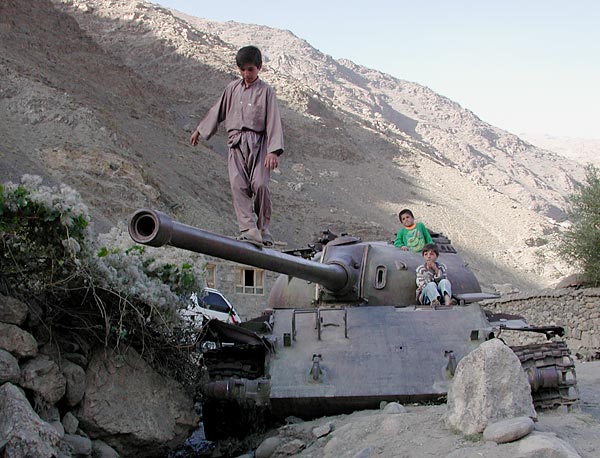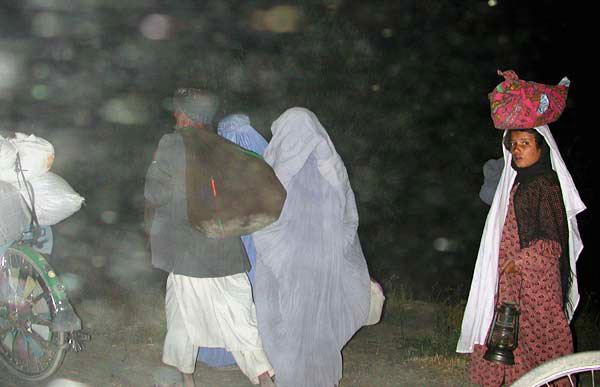Afghanistan’s adults unanimously say they are tired of fighting, but their children seem to enjoy the numerous paraphernalia of war, from tanks to heavy guns to grandfathers’ rifles, that one can encounter virtually everywhere, from one’s home to a village maidan. And even if the peace that has finally come to that country is there to stay, it will take many years before we see a generation who would rather bake cakes out of mud or build castles in the sand.
Soviet tanks and APCs provide top entertainment for small kids who set up their playgrounds near the armored vehicles or their rusting remains that lie scattered around Northern Afghanistan, which saw fierce fighting in the 1980s.
In the Panjshir Valley, broken tanks are used as support pillars for bridges, as dam structures – or as big toys for numerous local boys who spend hours balancing on the barrels or playing hide-and-seek in the turrets.
The problem, if anyone in Afghanistan believes it is a problem, is that fathers, who fought almost non-stop over the past twenty years, still keep their Kalashnikovs and other guns at home, despite numerous attempts by authorities to disarm the local population.
This practice encourages children to regard weapons at home as something normal. Kids, at times emboldened by their fathers, like playing with weapons, which often are loaded, although, to be fair, I’ve never heard of any cases of children being hurt at home. Children do get wounded and even killed when they find unexploded devices or land mines in the fields, near the roads, or in other outdoor locations where they come to play. Afghanistan is believed to have ten million pieces of unexploded ammunition, a lot of work for demining specialists for many years. Visitors to the country are advised – at least I would advise them – not to walk in the fields or look for toilet facilities in ruined houses while on the road and in urgent need to answer the call of nature. You may be in for a nasty surprise when you least expect it: with your pants down.
Sure enough, education, as far as intolerance towards weapons is concerned, doesn’t begin at home. Although most parents don’t want their children to be warriors like themselves, but wish them to grow in peace and become teachers or engineers, they tend to mistrust the government’s disarmament efforts, which began nationwide in early 2002, out of fear for their safety in a country that remains divided along ethnic and religious lines. According to this logic, being able to handle a gun remains one of the top priorities for boys.
At the height of the Northern Alliance’s war against the Taliban regime in 2001, I saw fighters as young as 14 years old, who proudly displayed their Kalashnikov assault rifles and deftly manipulated powerful anti-aircraft guns and other weaponry.
In the town of Khawak in the Hindu Kush mountains, through which my colleagues and I were traveling by car from the Panjsher Valley to Feyzabad, the capital of Badakhshan Province, the trip I’m going to describe later in my Web-based narrative, we met a diminutive 16-year-old boy, Hakimmudin, who told us of his “lifelong” dream: to get an AK-47.
For now he had to make do with his great-grandfather’s vintage rifle, apparently manufactured by the British circa 1900. Its barrel and all other metal parts were properly oiled, while the wooden butt was lovingly wrapped in purple velvet. Khawak was pretty far from the front line, so we only hoped Hakimmudin would never have to shoot at his Taliban pals, the more so since the confrontation between the Northern Alliance and its adversaries was drawing to an end. It is worth mentioning that the AK-47 and numerous other automatic weapons, designed by Soviet engineer Mikhail Kalashnikov, were commonly used by all the warring parties in Afghanistan. As a matter of fact, not just in Afghanistan: armies in fifty countries are armed with Kalashnikov-designed guns. A total of sixty million people are estimated to have been killed by this family of deadly weapons all over the world in numerous armed conflicts since the first model, AK-47, rolled off the assembly line in 1949. The fact that “Kalashnikov” was not merely a piece of weaponry, but also a proper name, always bewildered my Afghan interlocutors. And when I started my conversation by saying that my news organization interviewed Mr. Kalashnikov back in Russia and that I personally met the then 82-year-old weapons designer, I got such an astounding and sympathetic reaction that I thought one would never be able even to invent a better way to win confidence of any field commander or foot soldier, no matter how tense or unwelcome they might have seemed to be at first sight. All too often I had to resort to this trick again and again to establish a new relationship and win friends as my job took me to other places around Afghanistan and other countries, including my native Russia.
Not infrequently, mujahedeen asked me to photograph them, even though I used a digital camera and they never expected to get pictures. But those were offers I never refused, especially since they usually came from both partners: Kalashnikov and its owner.
Afghans, at least those who live in Northern Afghanistan, are very friendly people who don’t hold the grudge for long. On learning I was Russian, many fighters routinely inquired if I served in the Soviet army during its occupation of Afghanistan. First, I thought I was lucky that I didn’t (I completed my mandatory military service a year before the 1979-1989 Afghan War), as I probably wouldn’t have had the heart to confront my former enemies in the new capacity as journalist. Sometimes, however, I wished I had served in Afghanistan during the war, because in this case my discussions with muhajedeen would have been more personal. It’s not that I regret not having volunteered to go to Afghan.
Afghan fighters eagerly described their experience fighting the Soviets, or putting up with the Soviets when they were not able to fight. One young man, whose father was a mujahed in the 1980s, told me the Shuravi were funny.
“They would come into the village and ask people: dost or basmach? Then they would kill those who said they were basmach…” “But what was so funny about that?” I asked in disbelief. “Everybody in the village was a basmach, of course.” In Russian, the Turkic word “basmach,” borrowed in the 1920s when Soviet Russia was fighting for control of Central Asia, has come to mean “bandit” or “anti-government rebel.” In most languages spoken in Afghanistan, the word means “warrior.” “Dost,” of course, means “friend.”
Continuing the linguistic discussion, I must mention that Russian-speaking Afghans who learned the language during the Soviet occupation, or, more often, from their parents who learned some bits and pieces of the Russian language from the Soviet soldiers, also misuse Russian words a lot or misunderstand their true meaning or connotations, thus creating very funny situations. Once in a bazaar in Jabal os-Saraj, a young and polite Afghan man suggested a Russian female reporter buy a gold, rather than silver, bracelet, because, in his opinion, she was rolling in dough up to her dick, as I would roughly translate this typical Russian expression into English. Needless to say, he had no intention to offend the lady of the press; all he meant was that she must have had a lot of money and was able to afford buying a more expensive piece of junk.











